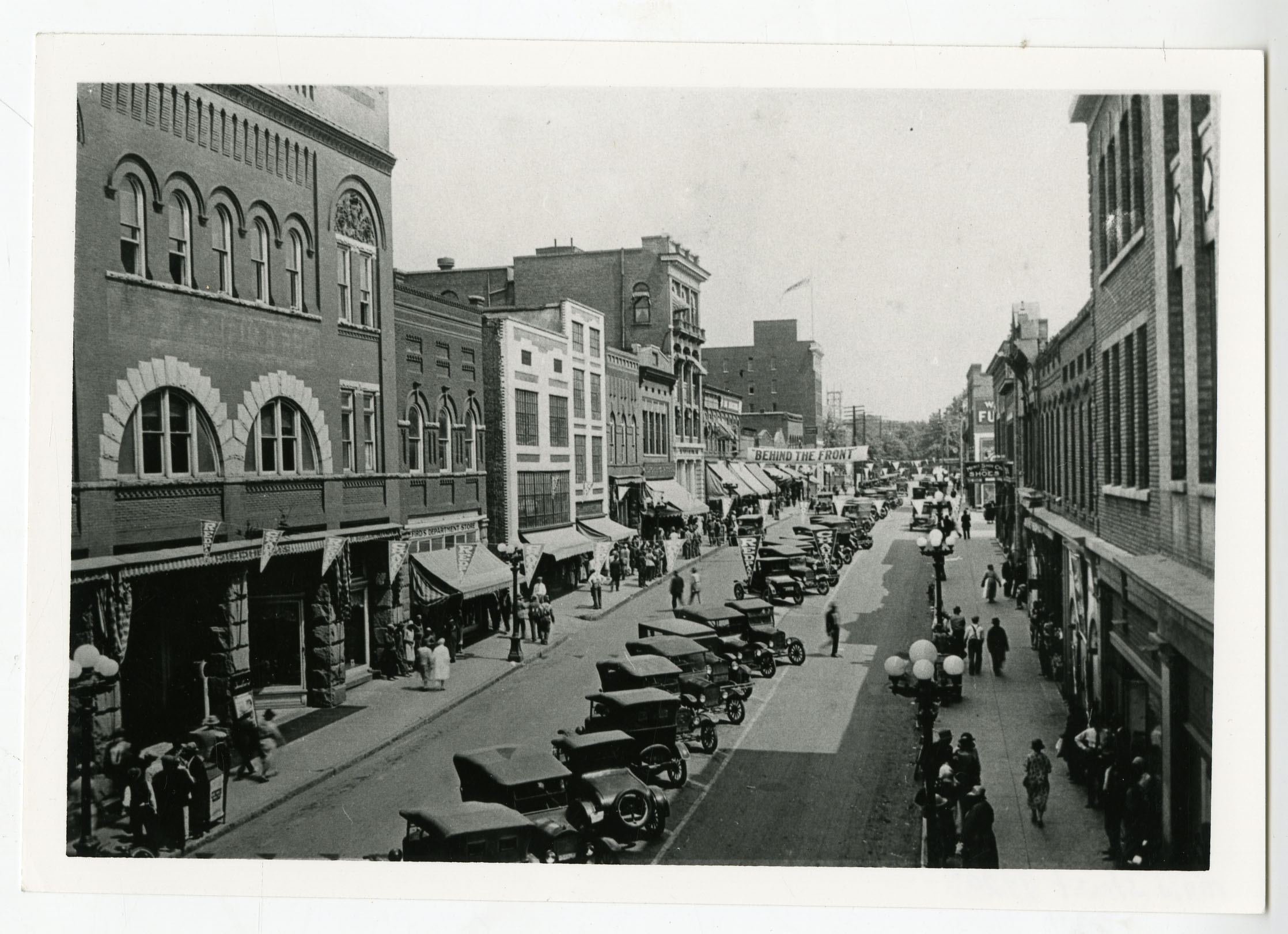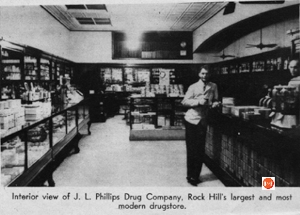“Three floors housed the National Union Bank, the Equitable Assurance Agency and many of Rock Hill physicians offices.”
City Directories and History: 1917 – National Union Bank, First Trust & Savings Bank, Sanitary Barber Shop, (103.5) Dunlap & Dunlap, Equitable Assurance Society, W.J. Roddey, and Company, 1946 – Barry’s Jewelry, Rock Hill Newsstand, Phillips Building: County Health Department, US OPA, Wallace W. Fennell, Gaston N. Quantz, Clarkson W. McDow, Wm. R. Blackmon, W. Frank Strait, 1963 – Baker & Myers, Paul M. Pittman, R.L. Youngblood, York County Girl Scout Council, Wm. R. Blackmon
The Rock Hill Herald reported on April 10, 1884 – “The Western Union Telegraph office is now in the basement on Main Street near the railroad in the space used for a longtime by Henry Toole as a barber shop. It is under the management of Mr. E.B. Rock. The office was formerly in the depot which burned last week.”
Rock Hill Herald, May 2, 1889: Mr. W. B. Wilson, Jr., has arranged to build a three-story brick
building on the vacant lot adjoining the building of Henry Toole.
The Herald reported on Sept. 3, 1902 that a new law firm has been formed as Spencer and Dunlap. C.R. Spencer and C.W.F. Spencer will welcome Walter M. Dunlap, the son of Major W.B. Dunlap. Mr. Dunlap will be in the Rock Hill office with C.W.F. Spencer. (This is at the Roddey Building also called the Equitable Building).
The Rock Hill Record reported on March 11, 1907 – “The Catawba Real Estate Company will be reorganized with J.M. Cherry as Pres., and James S. White as Sec. Treasurer. The offices are on the second floor of the National Union Bank Building in rooms #1 and 2. The company has been organized for five years but is now entering a higher level of business.”
The McElwee Store ledger recorded the account of Walter M. Dunlap and Lillian at their store. Mr. Dunlap was a partner at this location of Dunlap and Dunlap.
The Rock Hill Record reported on Feb. 15, 1912 – Improvements have been made to offices in the National Union Bank Building. The Equitable Assurance offices will move to the space previously occupied by Miller and White, Engineers and Surveyors, and that company will move to the rooms formerly used by Catawba Real Estate Company.

Note this early image shows one of Rock Hill’s Depot location as well as the fire station on North Trade.
The Herald reported on April 11, 1925 -” Peoples National Bank had assets of $2,743,867., the National Union Bank has assets of $2,200,654. and Citizens Bank and Trust has assets of $1,002,576.”
The Herald reported on April 29, 1941 – “A charter for a new jewelry store has been issued in Rock Hill. Barry’s Incorporated will sell jewelry, luggage, radios, electrical supplies and silverware. The officers are: H.C. Chandler, Pres., J. Kurtz, V.P., and B.P. Kurtz, Sec. -Treasurer. ”
The Herald reported on Oct. 15, 1941 – “The law firm of McDow and Jordon has been dissolved. W. Clarkson McDow will continue to practice in his office above Phillips Drugstore. Frank E. Jordon, Jr., will have offices on the third floor of the Phillips Building at the corner of Mail and Trade.”
Also see Lot #1 – North
The City of Rock Hill began their urban renewal project to transform the city in the late 1960s and it continued into the early 1970s. It involved the demolition of hundreds of homes and private businesses in the African American area as well as the East Black, West Black, Johnston, Hampton, and Trade Street corridors were all affected. Within a short span, nearly 40% of Rock Hill’s older downtown buildings were destroyed to provide economic opportunities, benefiting a few businessman. As part of this action, the railroad lines were moved and a new bridge crossing over Black Street was built to also alleviate traffic jams created by trains but in doing so, the old Rock Hill Depot building was also razed.

Early undated image of the “Hill” in Rock Hill’s downtown. Images from the Old Rock Hill Collection of AFLLC – 2012
But the most transformative aspect of the move was to add municipal buildings to the landscape; the Rock Hill City Hall, the Center for Aging, the Library and the Rock Hill Police Department buildings.
ROCK HILL’S FIRE OF 1898 – by Louise Pettus
The north side of Rock Hill’s main street lay in ashes after an early Sunday morning fire that burned for four and a half hours on April 3, 1898. Drunken loafers in a barber shop were blamed for the disaster. It was not Rock Hill’s first major fire. In 1878, 20 Main Street buildings had burned. In 1883 one-half of the west side of Main was lost. In 1887 half the town’s businesses were lost and the post office was torn down in order to prevent the fire from reaching the town library. Merchants built back and two years later fire almost destroyed the entire business district.
In 1898, five of the town’s largest buildings and several smaller shops went up in flames. All of the buildings were brick and only 11 years old. Roddey’s Hall was a two-story brick with O’Neal’s general merchandise store on the first level and an opera house on the upper level. Next door, Andrew J. Evans’ drug store burned along with J. H. Milling’s grocery. The offices of The Rock Hill Messenger also went up in flames.
The Yorkville Enquirer of April 27, 1876 reported – “Mrs. Reid’s school for young ladies recently presented a program in Thespian Hall.”
The Herald reported on Aug. 13, 1882 – “Mr. W.L. Roddey has recently had several scenes painted for the state in his hall. The work was executed by Mr. Reynolds, a master artist. The painting on the drop curtain is a scene on the Rhine River.”
Capt. W. L. Roddey, besides losing his opera house, lost a building he rented to J. B. Johnson & Co., druggist, and the offices of Simpson & Son, Dentists and Dr. Wallace Fennell’s medical office. – A. Friedheim & Bro, a general merchandise store with the Masonic Hall on the upper floor, was lost. The fire was stopped by an alleyway after destroying A. E. Smith’s building. The A. E. Smith building housed about 10,000 military cartridges and a large quantity of fireworks. All of the bullets and fireworks went off waking the town. It was a blessing that the bullets and fireworks exploded before the firefighters and onlookers arrived on the scene.
Later, there was an explosion at the Johnson drug store which blew out the windows and left a number of people cut by flying glass. Then, at Friedheim’s, the last store to go, the fire set off a goodly amount of gun powder, causing the whole building to collapse. It was obvious that the Rock Hill fire department would not be able to contain the fire without assistance. They telegraphed to Chester and Charlotte for help. Charlotte sent a fire engine by train but it was too late to help. Across the street a number of stores were damaged by the explosions and the heat. The heroes of the day were Herbert M. Davis and Manlius Owens, young firemen who wrestled water hoses to the top of the A. E. Smith building but were thwarted by low water pressure from the fire department’s steam engine. The steam engine was named “Marian Jones” for the fire chief’s daughter. There were no water mains or hydrants.
The total financial loss totaled about $175,000 with approximately $110,000 in insurance. There had been a fire in the spring of 1887 which had destroyed all of the opposite side of the street. In the 1887 fire all losses were covered but the insurance rates had risen as a result and in 1898 not everyone carried adequate replacement insurance. The Rock Hill Messenger carried no insurance and ceased publication. Spectators had carried out much of the merchandise from the burning stores. Left in the street, much of the rescued goods was stolen. Capt. W. Lyle Roddey decided to not rebuild the opera house. The old one was not a money maker, largely because traveling entertainers came infrequently. Also, Roddey was expected to offer the auditorium free for numerous charitable causes. The space would have been much more profitable if it had been used for offices or shops.
The first merchant house to rebuild was Friedheim’s Store, now the oldest building in downtown and occupied by First Union Bank. (Information courtesy of and from: YCGHS – The Quarterly Magazine)
Stay Connected
Explore history, houses, and stories across S.C. Your membership provides you with updates on regional topics, information on historic research, preservation, and monthly feature articles. But remember R&R wants to hear from you and assist in preserving your own family genealogy and memorabilia.
Visit the Southern Queries – Forum to receive assistance in answering questions, discuss genealogy, and enjoy exploring preservation topics with other members. Also listed are several history and genealogical researchers for hire.
User comments welcome — post at the bottom of this page.

Additional views of the area which gave the town its name. Images from the Old Rock Hill Collection of AFLLC – 2012


Please enjoy this structure and all those listed in Roots and Recall. But remember each is private property. So view them from a distance or from a public area such as the sidewalk or public road.
Do you have information to share and preserve? Family, school, church, or other older photos and stories are welcome. Send them digitally through the “Share Your Story” link, so they too might be posted on Roots and Recall.
Thanks!
User comments always welcome - please post at the bottom of this page.










Share Your Comments & Feedback: